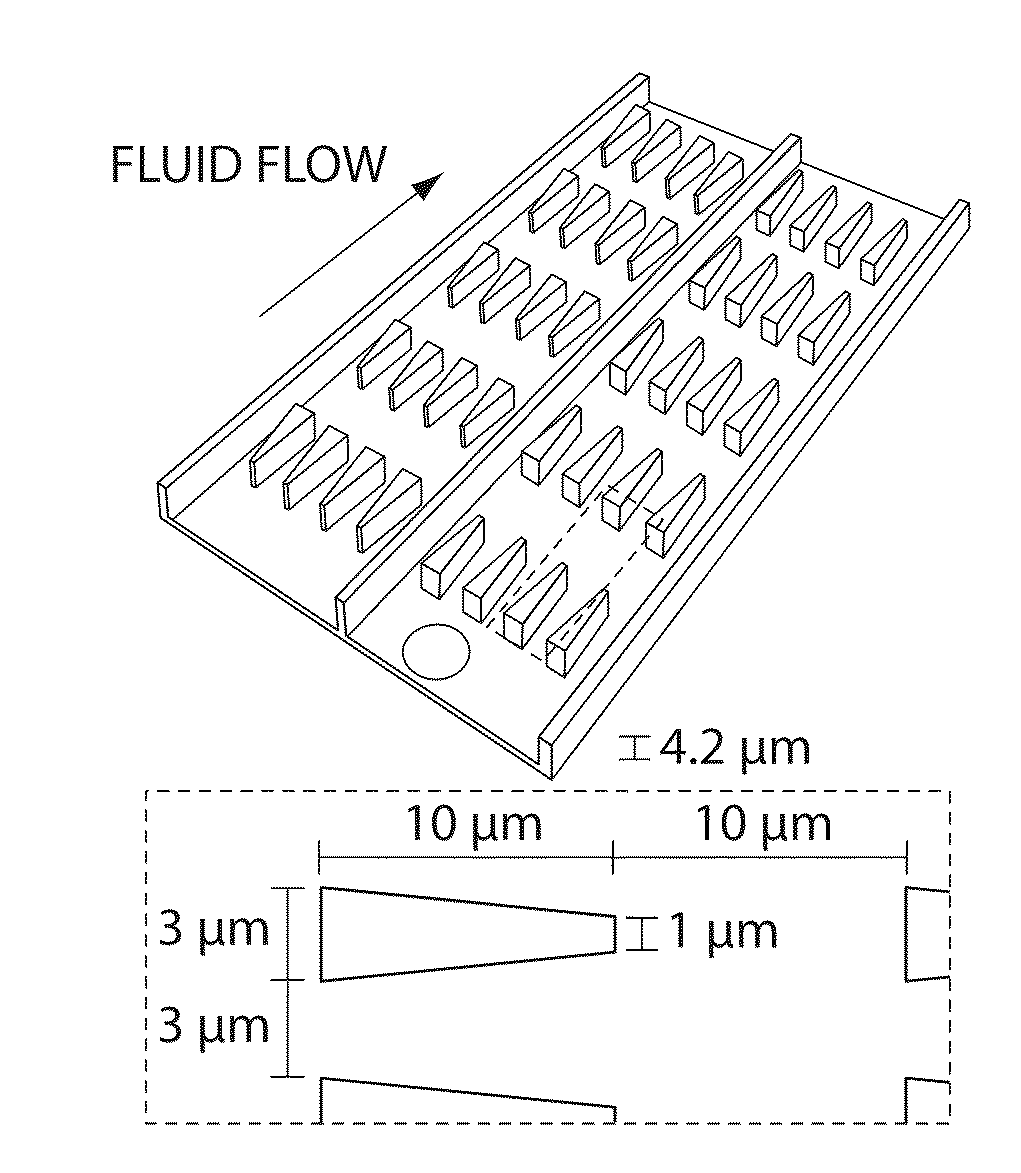Computational methods and compositions
- Summary
- Abstract
- Description
- Claims
- Application Information
AI Technical Summary
Benefits of technology
Problems solved by technology
Method used
Image
Examples
example 1
An Automated Deformability Cytometer
[0314]An automated, microfabricated ‘deformability cytometer’ that measures dynamic mechanical responses of approximately 103-104 individual RBCs in a population has been developed. The device provides a novel method relying on low Reynolds number fluid mechanics to evaluate the effect of entrance architecture on the sensitivity of cell deformability measurements. The device can be used with many different cell types and used in field diagnostic applications. In some embodiments, optimized pore geometries have been identified using the device, which are suited for “deformability selection” of cells.
[0315]An algorithm was developed using commercially available software to automate video processing and facilitate the analysis of thousands of RBCs. In some embodiments, this high throughput device enabled the measurement of statistically significant differences in deformability between two cell populations. Fluorescence measurements on each RBC were s...
example 2
Dissipative Particle Dynamics (DPD) Simulation of Cell Deformation Through Different Constriction Geometries
[0337]A Dissipative Particle Dynamics (DPD) model was built to translate the experimental measurements from the deformability cytometer into quantitative data describing the mechanical properties of individual RBCs.
[0338]Three-dimensional simulations of healthy and malaria-infected cells were performed using the DPD method. Infected cells were modeled with increased shear modulus and membrane viscosity values obtained from quantitative experimental measurements performed by recourse to optical tweezers stretching of the parasitized RBCs (15). The parasite was modeled as a rigid sphere, 2 microns in diameter (27), placed inside the cell (FIG. 1C). Snapshots from simulations showing passage of an infected RBC through channels with converging and diverging pore geometries are shown in FIG. 1D. Simulations were able to capture the effects of pore geometry and changes of RBC proper...
examples 1 and 2
References for Background and Examples 1 and 2
[0344]1. McMillan D, Utterback N, La Puma J (1978) Reduced erythrocyte deformability in diabetes. Diabetes 27: 895-901.
[0345]2. Cranston H, et al. (1983) Plasmodium falciparum maturation abolishes physiologic red cell deformability. Science 233: 400-403.[0346]3. Mokken F C, Kedaria M, Henny C P, Hardeman M, Gleb A (1992) The clinical importance of erythrocyte deformability, a hemorrheological parameter. Ann. Hematol. 64: 113-122.[0347]4. WHO (2008) World Malaria Report 2008[0348]5. Maier A, Cooke B, Cowman A, Tilley L (2009) Malaria parasite proteins that remodel the host erythrocyte. Nature Reviews Microbiology 7: 341-354.[0349]6. Suresh S, et al. (2005) Connections between single-cell biomechanics and human disease states: gastrointestinal cancer and malaria. Acta Biomaterialia 1: 16-30.[0350]7. Safeukui I, et al. (2008) Retention of Plasmodium falciparum ring-infected erythrocytes in the slow, open microcirculation of the human spleen...
PUM
 Login to View More
Login to View More Abstract
Description
Claims
Application Information
 Login to View More
Login to View More - R&D
- Intellectual Property
- Life Sciences
- Materials
- Tech Scout
- Unparalleled Data Quality
- Higher Quality Content
- 60% Fewer Hallucinations
Browse by: Latest US Patents, China's latest patents, Technical Efficacy Thesaurus, Application Domain, Technology Topic, Popular Technical Reports.
© 2025 PatSnap. All rights reserved.Legal|Privacy policy|Modern Slavery Act Transparency Statement|Sitemap|About US| Contact US: help@patsnap.com



